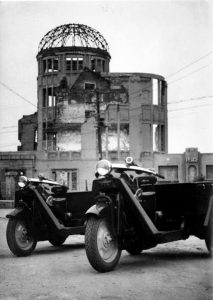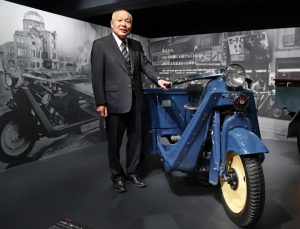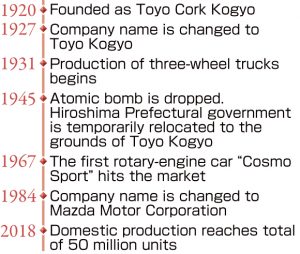Hiroshima Summit—Recovery after A-bombing, Part 3: Mazda Motor
Apr. 2, 2023
Three-wheel “Batanko” truck led logistics, distribution industry in Japan
by Yuki Kuwata, Staff Writer
In September 1945, the month after the atomic bombing of Hiroshima, senior managers at Toyo Kogyo (present-day Mazda Motor Corporation) were visiting a company factory in Fukuoka Prefecture’s Kurume City. The purpose of their visit was to estimate the purchase of tires for production of its three-wheel truck amid what was at the time a shortage of raw materials.
Nobuhiro Hayama, 75, a former Mazda director who now lives in Hiroshima’s Minami Ward, remembered the words of his late father, Tsuneyoshi Hayama, a former Mazda engineer. “I took the train to get the tires,” Nobuhiro recalled the father as saying. Tsuneyoshi rarely talked about those times, but memories would sometimes slip out he would drink. Nobuhiro explained, “The truck model helped Hiroshima make it through those days. He must have been proud.”
The three-wheel truck, which first appeared on the market in 1931, was the first automobile Mazda produced. With two rear wheels positioned to the right and left and a single front wheel, the vehicle was equipped with an air-cooled, single-cylinder engine that had been developed by the company. Even under a full load, the truck could be driven smoothly on narrow, gravel roads. A sales catalogue back then touted the truck. “All components of the truck, including every nut and bolt, are strictly manufactured and tested by Toyo Kogyo itself,” read the brochure. Such language revealed the company’s pride as an up-and-coming automobile manufacturer.
During the war, Mazda produced a two-wheel vehicle for military use with a sidecar and small armaments. On the day of the atomic bombing, Toyo Kogyo lost 119 of its employees engaged in the dismantling of buildings to create fire lanes for the war effort. Tsuneyoshi, then 20, with a seven-year career at the company, was drafted into the Japanese Army and experienced the atomic bombing when engaged in code-breaking work at the Army’s Second General Headquarters (in what is now Hiroshima’s Higashi Ward). After losing consciousness multiple times, Tsuneyoshi managed to reach nearby Mt. Futaba on foot and receive treatment for wounds caused by impaled glass shards.
Mazda’s factory, located in present-day Fuchu-cho just outside the city in Hiroshima Prefecture, suffered only minor damage in the atomic bombing. However, as a result of the devastation, no materials were available. Production of the three-wheel truck resumed in December 1945, four months after the bombing. Nobuhiro, the son, has heard stories from that time. “Ten units at first, and then little by little more and more units were produced,” described Nobuhiro.
The three-wheel trucks were useful for carrying materials in support of the work to restore Hiroshima. Mazda has in its archives photographs showing the three-wheel trucks displayed in front of the former Prefectural Industrial Promotion Hall, now known as the A-bomb Dome, located in Hiroshima’s Naka Ward, which were taken at the time a new model hit the market. The photos show the development and changes of the neighboring cityscape of Hiroshima, including the former municipal baseball stadium, in tandem with evolution of the vehicle, which over time took on such features as windows and a roof.
Mr. Hayama started work at Toyo Kogyo in 1974, dedicating himself to research and development of the rotary engine, a unique technology developed by the company. This small, light-weight engine became the impetus for Mazda throwing its hat into the ring of the four-wheel vehicle market. The rotary engine has endured repeated life-or-death crises, which forced continuous improvements in environmental performance. The engine, also utilized as a power generator, now plays a part in Mazda’s electric-vehicle strategy.
At times, Tsuneyoshi aimed harsh words at his son, who began his own career in the company, about his relaxed work ethic. Nobuhiro sympathized with his father. “Maybe he wanted to tell me I should be more committed to making Hiroshima and the world a better place.” The three-wheel truck, the genesis of Mazda’s post-war history, now welcomes visitors as the first vehicle on display at Mazda Museum, located in Hiroshima’s Minami Ward.
In October 1931, Mazda started to produce the three-wheel truck called Mazda-Go DA. The truck, nicknamed “Batanko” in Japanese, grew to be a mainstay in logistics and distribution for driving on unpaved roads, until the time four-wheel cars came into popular use. In 1932, that model was exported to China for the first time. In 1936, Mazda formed a public-relations caravan that traveled from Kagoshima Prefecture to Tokyo using the three-wheel truck, in an attempt to market the vehicle’s superlative performance.
The GA model, on sale from 1938 through 1949, had a unique structure that placed a shift lever at the driver’s seat in front of the gauges on the dashboard. That allowed drivers to operate the shift lever more easily with either hand when turning the steering wheel. All of which illustrate why the truck was able to support people’s daily lives both before and after the war.
(Originally published on April 2, 2023)










